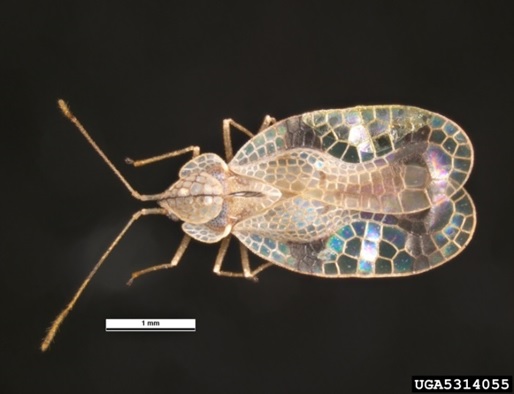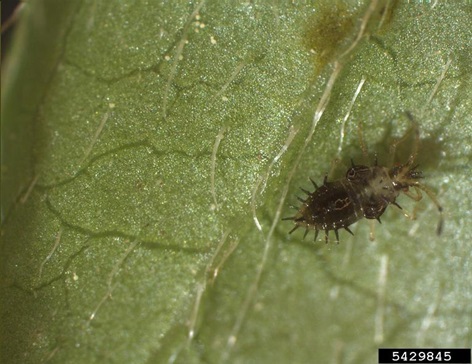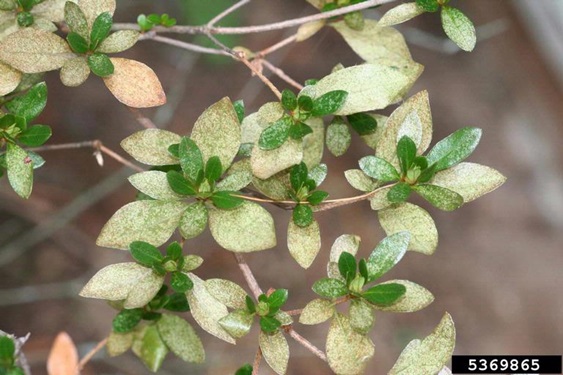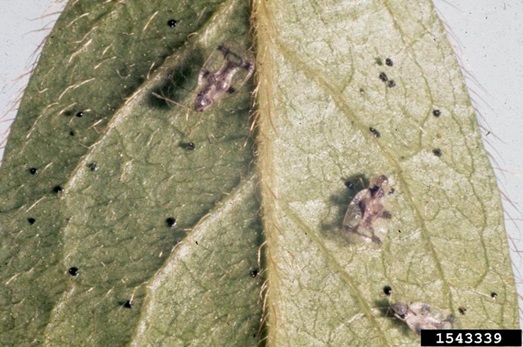Azalea Lace Bug Management
ENTFACT-470: Azalea Lace Bug Management | Download PDF
Jonathan L. Larson, Extension entomologist
University of Kentucky College of Agriculture
Fast Facts
- Lace bugs are so named for the lace-like appearance of their adult wings and thin outgrowths on their thorax.
- Lace bugs tend to feed on the undersides of leaves and are sucking pests that use needle like mouthparts to siphon fluids from the host plant, inducing stippling and chlorosis of infested leaves. They also produce dark fecal droppings that resemble motor oil.
- Previously infested plants can be treated in the spring with insecticidal soaps, horticultural oils, or neem to kill nymphs. In addition, spring applications of systemic products containing acephate, imidacloprid, dinotefuran, and chlorantraniliprole will prevent lace bug populations from establishing or building on plants.
Host Plants
Evergreen azaleas are more prone to infestation, but deciduous azaleas are susceptible to lace bugs as well.

Symptoms and Pest Description
Adults are about 1/8th inch long and have lacy wings and projections from the thorax that give the insect its common name. The wings may be clear or there can be dark brown or black markings on them as well. Nymphs (immature insects) are small, wingless, and have black bodies with spiny projections.

Lace bugs feed by inserting their needle-like mouth into leaves and siphoning out the juices inside. Initially, this will result in stippling, where the leaves have a dotted or pale look. As the damage accumulates though, the stippling will congeal, leaving whole leaves looking bleached, silvery, or chlorotic.

This damage can superficially resemble mite feeding. Unlike mites though, lace bugs leave behind characteristic liquid black fecal droppings. This looks a bit like motor oil has been sprinkled on the leaves.

Life History in Kentucky
Lace bugs overwinter as eggs laid on the undersides of leaves. Most eggs will be laid near the midrib of the leaf, though they can also be found near other large veins. They are protected through the winter by a smear of hardened fecal material on top. The eggs will usually hatch by late spring or early summer. The resulting nymphs will progress through multiple instars (development stages) to reach adulthood. The speed of this progression is dependent upon temperature, but in warmer conditions, a lace bug can become an adult in under 30 days. There are multiple generations per year, usually between two to four.
Management
Though some damage is mostly aesthetic, repeated infestations of lace bugs can weaken and even contribute to mortality of the plant. Additionally, plants with 4 generations per year will experience considerably more stress than those with 2. The damage is easy to monitor in the spring to determine if intervention is necessary. Inspecting plants can also involve tapping suspect leaves over blank white paper to observe nymphs/adults. When planting azaleas, it has been noted that those growing in the shade suffer from fewer lace bugs due to an increase in natural enemies.
If lace bugs are discovered, a strong jet of water can dislodge them. Chemical control can also be effective. Newly emerged nymphs can be targeted in the spring with insecticidal soaps, horticultural oil, or neem or with contact insecticides such as bifenthrin or other pyrethroids. Alternatively, in the late spring, systemic applications of an insecticide product containing dinotefuran, imidacloprid, chlorantraniliprole, or acephate in the soil will grant season long suppression of lace bugs and prevent damage from occurring.
03/25 (Issued)
